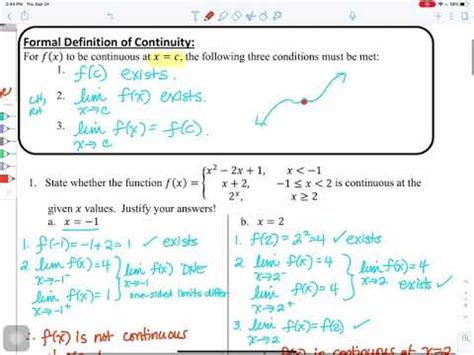In mathematics, the concept of continuity plays a pivotal role in describing the behavior of functions. Informally, a function is said to be continuous at a point if its value changes smoothly as the input approaches that point. This means that there are no sudden jumps or breaks in the function’s graph at that point.

More formally, a function f(x) is continuous at a point c if the following condition holds:
For every ε > 0, there exists a δ > 0 such that whenever |x – c| < δ, we have |f(x) - f(c)| < ε.
In other words, for any arbitrarily small positive number ε, we can always find a positive number δ such that if the distance between x and c is less than δ, then the difference between f(x) and f(c) is less than ε.
Geometrically, this condition means that the graph of f(x) can be drawn without lifting the pen from the paper at the point (c, f(c)). There is no break or jump in the graph as x passes through c.
Examples of Continuous Functions
- The function f(x) = x^2 is continuous at all points. This is because for any ε > 0, we can choose δ = √ε. Then, for any x such that |x – c| < δ, we have:
|f(x) - f(c)| = |x^2 - c^2| = |(x - c)(x + c)| < √ε * (|x| + |c|) < √ε * (√ε + |c|) = ε
- The function f(x) = sin(x) is continuous at all points. This is because for any ε > 0, we can choose δ = ε/2. Then, for any x such that |x - c| < δ, we have:
|f(x) - f(c)| = |sin(x) - sin(c)| ≤ 2|sin((x - c)/2)| < 2|x - c|/2 = |x - c| < ε
Examples of Discontinuous Functions
- The function f(x) = |x| is not continuous at x = 0. This is because as x approaches 0 from the left, f(x) approaches -0, while as x approaches 0 from the right, f(x) approaches 0. There is a sudden jump in the graph at x = 0.
- The function f(x) = 1/x is not continuous at x = 0. This is because as x approaches 0, f(x) approaches infinity. There is a break in the graph at x = 0.
Applications of Continuity
The concept of continuity is essential in many areas of mathematics and its applications. Some examples include:
- Calculus: Continuity is a fundamental requirement for functions to be differentiable and integrable.
- Physics: Continuity is used to model the smooth flow of fluids and the continuous motion of objects.
- Engineering: Continuity is used to design structures that can withstand continuous loads and stresses.
- Economics: Continuity is used to model the continuous flow of goods and services in a market.
Conclusion
Continuity is a fundamental property of functions that describes their smooth behavior as the input changes. It has important applications in various fields, including calculus, physics, engineering, and economics. Understanding the concept of continuity is essential for mastering these and many other areas of mathematics and its applications.
